Keeping you healthy is a massive team effort. In a single drop of your blood there are thousands of white blood cells doing different jobs. From raising the alarm on dangers, to coordinated attacks on infection, and even just keeping the whole system in balance, your white blood cells are a diverse and elite team. Each of these cells will take centre stage on the blog at some point, but for now I’d like to give you a quick introduction to all of them and the main jobs they do. Meet the team!
Innate Immune cells
These are the first responders of your immune system. They quickly recognise threats to your body, for example bacteria, viruses and parasites, which are often called pathogens. Without knowing exactly what they’re seeing, they have some knee-jerk reactions which kick in quickly to keep you safe.
Granulocytes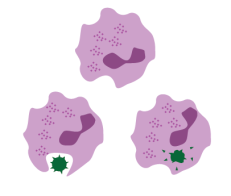
So called because they have granules inside them (little packets of chemicals which actually make the cells look grainy under a microscope), granulocytes come in different types. Eosinophils and Basophils are good at fighting off parasites, but they can also contribute to allergic reactions. Neutrophils patrol your blood constantly and when they find a pathogen they pull it inside the cell to be broken down. This process of eating up pathogens is called phagocytosis.
Natural Killer cells
No prizes for guessing this cell’s special skill set. Natural Killer cells look for a small structure on the surface of the cell called MHC (MHC are really important and exciting, so look forward to hearing about them in the future) which identifies your cells as part of your ‘self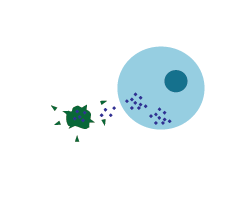 ’. If they don’t find this on the cell then they kill it. They can do this by slipping packets of chemical poison into the cell or switching on the cell’s self-destruct mechanism. Natural Killer cells are a focus of my lab’s research. They’re a relatively recent discovery; they weren’t even named until the 1970’s. We know they are important for killing virus infected and cancer cells, but new ways they work and jobs they might do are still emerging. This makes them a really exciting cell to work on.
’. If they don’t find this on the cell then they kill it. They can do this by slipping packets of chemical poison into the cell or switching on the cell’s self-destruct mechanism. Natural Killer cells are a focus of my lab’s research. They’re a relatively recent discovery; they weren’t even named until the 1970’s. We know they are important for killing virus infected and cancer cells, but new ways they work and jobs they might do are still emerging. This makes them a really exciting cell to work on.
Monocytes, Macrophage and Dendritic Cells
Monocytes are cells in your blood which can develop into Macrophage or Den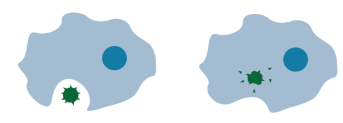 dritic cells. Like Neutrophils, Macrophage are great at eating up pathogens. As well as being in your blood, special Macrophage can sit in organs like your brain, liver and lungs doing jobs specific for those places.
dritic cells. Like Neutrophils, Macrophage are great at eating up pathogens. As well as being in your blood, special Macrophage can sit in organs like your brain, liver and lungs doing jobs specific for those places.
Dendritic cells play a special role linking your innate and adaptive immune systems. They are Antigen Presenting Cells (APCs). They find small pieces of pathogen, called antigens, and stick 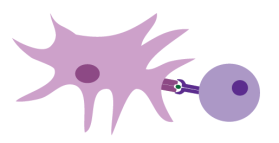 them to MHC (there it is again!) on their surface to show them to T cells and B cells. This switches on the cells. Macrophage can do this too, but Dendritic cells are particularly good at it. I also have a soft spot for Dendritic cells as looking at how they talk to Natural Killer cells is a big part of my PhD project.
them to MHC (there it is again!) on their surface to show them to T cells and B cells. This switches on the cells. Macrophage can do this too, but Dendritic cells are particularly good at it. I also have a soft spot for Dendritic cells as looking at how they talk to Natural Killer cells is a big part of my PhD project.
Adaptive Immune cells
These cells take a bit longer to get working. They recognise a specific pathogen and can produce a custom reaction to fight it more effectively. They’re also the memory of your immune system. Once they’ve figured out a custom reaction once, memory versions of these cells stick around in your body. This means that the next time you encounter the same illness, you can fight it off more quickly.
B cells
The main job of B cells is to make antibodies. These are Y shaped proteins specially shaped to stick to a particular pathogen. They can eliminate invaders by setting off a chemical chain reaction which makes holes in the pathogen. Alternatively they signal to other immune cells to help out, asking macrophage to eat the invader or natural killer cells to kill it. Each B cell makes one shape of antibody to stick to one target. When you have an infection, Antigen Presenting Cells help to switch on the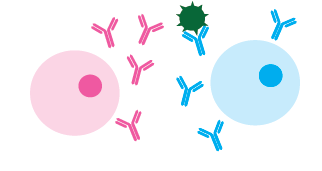 right B cell to make antibodies to stick to that particular pathogen. These switched on B cells make lots of copies of themselves to produce plenty of antibodies, and memory B cells so that you can quickly produce antibodies next time you are infected.
right B cell to make antibodies to stick to that particular pathogen. These switched on B cells make lots of copies of themselves to produce plenty of antibodies, and memory B cells so that you can quickly produce antibodies next time you are infected.
T cells
T cells are pretty much the managers of the whole system, and they come in different styles. Killer T cells (called cytotoxic T cells) eliminate pathogens in the same way as natural killer cells, but they are switched on by an Antigen Presenting Cell to target a particular pathogen. Helper T cells are also switched on by APCs, and coordinate the immune response by sending out chemical messages to other cells. They can help tailor the response to specific types of pathogen like viruses, bacteria or parasites. Regulatory T cells stop all the other cells from damaging your body with an over enthusiastic immune response. They keep the system in balance. And then there are the memory versions of all these cells.
but they are switched on by an Antigen Presenting Cell to target a particular pathogen. Helper T cells are also switched on by APCs, and coordinate the immune response by sending out chemical messages to other cells. They can help tailor the response to specific types of pathogen like viruses, bacteria or parasites. Regulatory T cells stop all the other cells from damaging your body with an over enthusiastic immune response. They keep the system in balance. And then there are the memory versions of all these cells.
This is not a complete list of every detail about these cells. The immune system is amazingly complex and I could write a couple of books trying to cover all the ways these cells work. But hopefully this is enough to get an idea of the different jobs your white blood cells do for you. When I write in more detail or post news about particular cells you can come back to this to see how they fit into the bigger picture. You’ve met the team, now let the games begin!

[…] pieces of the pathogen we want to vaccinate against, we trigger a small immune response. This makes memory antibody producing B cells which kick into action when you encounter the real pathogen and stop it from taking […]
LikeLike
[…] many autoimmune diseases one of these parts is T cells. But if you remember from our roundup of immune cells, there is a special type of T cell called T regulatory cells which can keep the immune response in […]
LikeLike
[…] growth than the sedentary mice. They then looked at the immune cells in these mice and found that Natural Killer cells were much more active in the tumours of the running mice. Natural Killer cells are innate immune […]
LikeLike
[…] your nose as you inhale. In hay fever sufferers white blood cells called mast cells, a type of granulocyte, are switched on by the pollen. This is happens because they are covered with antibodies which are […]
LikeLike